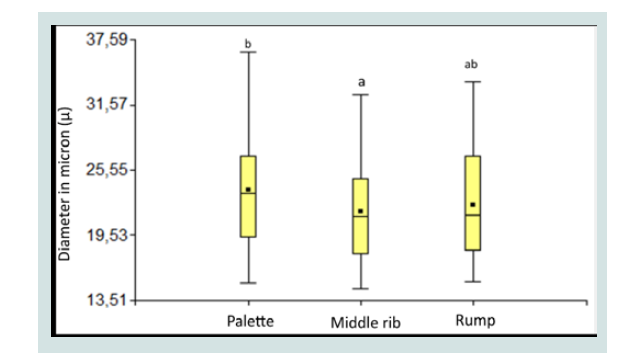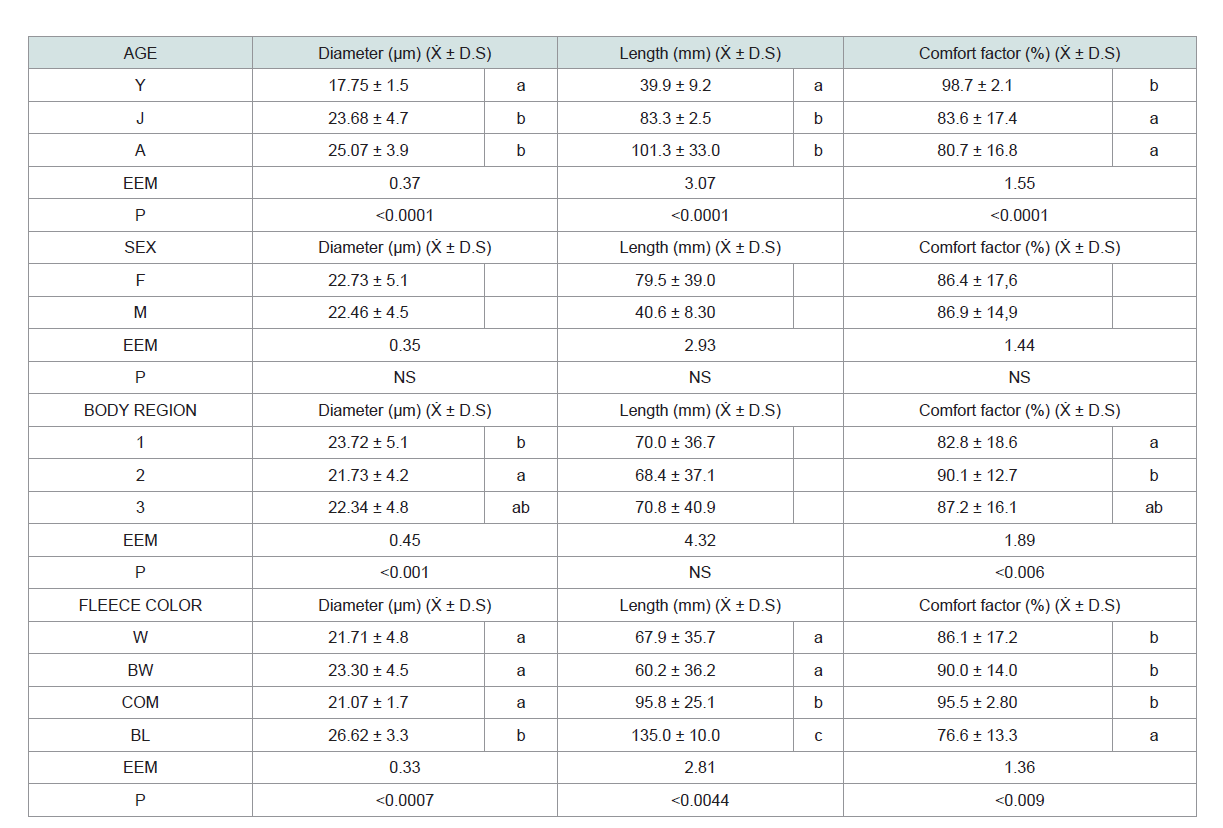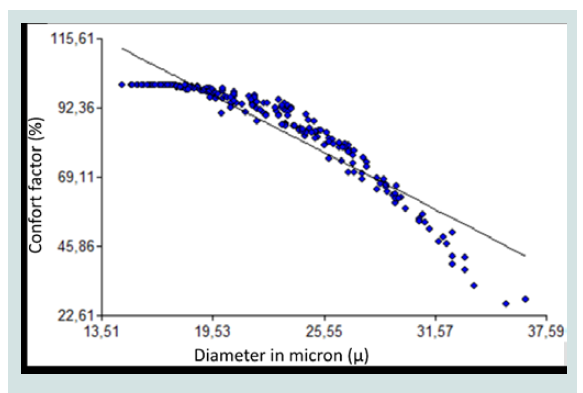Journal of Veterinary Science & Medicine
Download PDF
Research Article
Lanametric Determination of the Alpaca Fiber (Vicugna Pacos) in Tucayta, Province of Cañar
Simbaina Solano JC1* and Luis Raggi2
1Lanimetry Laboratory, University of Azuay, Chile
2University of Favet-Chile, Chile
*Address for Correspondence: Simbaina Solano JC, Assistant researcher “Azuay University”, Lanimetry Laboratory, Faculty of Veterinary and Animal Sciences, Chile University, Cuenca, Ecuador, Santa Rosa 11735, Santiago, Chile; E-mail: austrogenetica@gmail.com
Received date: 24-May-2019;
Accepted date: 28-June-2019;
Published date: 02-July-2019
Copyright: © 2019 Simbaina Solano JC, et al. This is an open access
article distributed under the Creative Commons Attribution License,
which permits unrestricted use, distribution, and reproduction in any
medium, provided the original work is properly cited.
Abstract
Alpaca fiber (Vicugna pacos) is classified as one of the finest animal fibers in the world, after the vicuna (Vicugna vicugna). Therefore, they are highly valued fibers by the textile industry. Its valuation is determined, among other variables, by fineness, which indicates its quality. To analyze some of the textile characteristics of these fibers, Optical-based bre Diameter Analyser 2000; (OFDA) equipment was used, in which t was possible to determine the average fiber diameter, length, and comfort factor. These characteristics were analyzed based on the variables of sex, age, color of the fleece, and body region. For this study, a multifactorial ANOVA was applied under a completely randomized design, and the R Project software was used. For separation of means, the Bonferroni test was used (P<0.05). The correlations between parameters were evaluated by the Pearson correlation coefficient. Results were: mean fiber diameter 22.6 μm ± 5.2; mean fiber length 60.8 mm, and mean comfort factor 86.8 %. In this way, the fibers analyzed are within the Baby alpaca category, cataloged fibers of better quality, with a high percentage of comfort factors. Additionally, it was observed that age, the body region and the fleece color directly influence the textile characteristics such as diameter, length and comfort factor; parameters that are very significant in the valuation of fiber for commercial purposes. In addition, the measurements could be used to compare with alpaca fiber used by native peoples in order to know the variations in these parameters over the centuries and to establish possible mechanisms to determine the origin of the fiber used in the ancient textiles.
Keywords
South American Camelids; alpaca; fiber; diameter; comfort factor
Introduction
In the province of Canar (located in the southern Ecuadorian region) alpaca breeding is used for fiber (hair) and meat production [1]. This camelid raising is encouraged by government agencies (MAG), which promote alpaca raising for family and large-scale herds. Alpaca raising constitutes a means of livelihood for native farmer’s families [2]. Alpacas are one of the four South American camelids (SAC) [3]. They take advantage of lands in geographical zones and extreme environmental conditions, where agriculture or the raising of other domestic animals is not viable [4]. These camelids generate meat, skin, and income from the sale of its excellent quality fiber, classified among fine animal fleece. These fibers provide softness and comfort textile garments. Therefore, the garments are considered luxury items of great commercial value [1,5]. In Ecuador, there are potentialities and genetic material for the production of alpacas in a competitive way and in important quantities, using resources such as Andean high plateau grasslands and protected forests. In addition, alpacas serve as a conservation animal resource for the Andean ecosystems [1]. In the Province of Canar, many families engage in this activity, considering fiber production as very important [6]. The diameter or fineness is significant in determining the quality, and at the same time, the price of the fiber in the market, which means that fibers of smaller diameter will be used to make finer garments [4]. The shearing yield of alpaca in the Province of Canar is approximately 2.2 kg/alpaca/year, with a raw fiber value of $2.00 to $8.00 and in yarn of $15.00 to $80.00 USD [1]. There are reports on the quality of fiber of alpacas in the Province of Canar, with a fineness that oscillates 21.72 μm [6], for which, they have used the Lanameter Reichert Projection Equipment (Meter of wool); livestock communities do not have reliable measurements of fiber quality and therefore the OFDA technique becomes a technological tool, fast and reliable, contributing not only to the evaluation of animals, but also to the selection of males and females for reproduction [7]. The present work was carried out in the alpaca herds of the TUCAYTA organization, for which, the OFDA 2000 (Optical Fiber Diameter Analyzer) was used, which allows a rapid and highly accurate analysis [8]. The purpose of the study was to know the characteristics of Huacaya alpaca fiber for textile future use (Vicugna pacos), such as mean Fiber Diameter (FD), mean Fiber Length (FL) and mean comfort factor (CF, percentage % of fibers equal to or less than 30 microns). Specific objectives were established such as determining the effect of sex, age, fleece color, and the effect of body region on the quality of the fiber.
Materials and Methods
The present research work was carried out on the TUCAYTA farms, located in the Patococha zone of the Province of Canar, located in southern Ecuador, at an altitude of 2738 meters above sea level, with a minimum temperature of 11 °C and maximum of 19 °C, average precipitation of 636 mm/year, humidity 94%, and wind up to 7 km/hour [9,10].
From a 200 alpacas head a sample size of 70 young and adult
alpacas, of different sex, was randomly selected. The data, such as weight, age, sex and color, of all of the animals under study were previously obtained and registered. Samples of hair from three different regions of the body were obtained: paddle, middle rib and rump [11]. Therefore, a fiber sample of approximately 10 g/animal was collected. Subsequently, placed in plastic bags properly identified for further OFDA analysis at the lanameter laboratory of the Faculty of Veterinary and Animal Sciences of the University of Chile, in Santiago, Chile. The data obtained were subjected to the ANOVA statistical analysis, and the R Project 2.8.1software was used. For the comparison of multiple ranges were made through the Bonferroni test at the level of significance (P <0.05); the Bonferroni test is a multiple comparison test that allows comparing means of sex, color, age and body region factors after performing the ANOVA technique. Therefore, the present statistical analysis will explain if the data set will have a normal distribution, with which the alternative hypothesis will be accepted. In addition, a Pearson correlation test was performed among the variables studied.
Results
Measurement of mean fiber diameter (MFD+SD), mean fiber length (MFL+SD) and mean comfort factor (MCF+SD) was recorded. MFD in the studied population was 22.6 μm ± 5.2; MFL of 60.8 mm; a MCF of 86.8%; and with a fiber percentage <to 15μm of 9.3%.
Fiber diameter: The MFD between the adult (A), juvenile (J) and young (Y) animals was categorized according to their age; Adults over 3 years of age, Juveniles from 1 to 3 years old, and Young forunder 1 year of age [12]. Therefore, the MFD between the animals A, J and Y found were: 25.07 μm ± 3.9; 23.68 μm ± 4.7; and 17.75 μm ± 1.5 respectively, with significant differences (P <0.05), (Table 1). The MFD among the animals of different sex was based on the Female (F) and Male (M) records. Therefore, the MFD between F and M were: 22.73 μm ± 5.1; and 22.46 μm ± 4.5 respectively, without significant differences. The MFD between different body regions was established by sample collection points of three regions of the body of the animal [10]: Palette (1), Middle rib (2), and Rump (3). Therefore, the MFD between regions 1, 2, and 3 found were: 23.72 μm ±.1; 21.73 μm ± and 22.34 μm ± 4.8 respectively, with significant differences (P <0.05), (Figure 1). Finally, the MFD between the different colors of the fleece is based on records: White (W), Brown (BW), Composite of 2 or more colors (COM) and Black (BL). Therefore, the MFD between the W, BW, COM, and BL color animals found were: 21.71 μm ± 4.8; 23.3 μm ± 4.5; 21.07 μm ± 1.7; and 26.62 μm ± 3.3 respectively, with significant differences (P <0.05).
Fiber length: The MFL among the animals A, J and Y found were: 101.3 μm ± 33.0; 83.3 μm ± 2.5; and 39.9 μm ± 9.2, respectively, with significant differences (P <0.05), (Table 1). The MFL between animal’s F and M were: 79.5 mm ± 39.0; and 40.6 μm ± 8.3 respectively, without significant differences (P <0.05). The MFL between body regions 1, 2 and 3 found were: 70.0 μm ± 36.7; 68.4 μm ± 37.1; and 70.8 μm ± 40.9 respectively, without significant differences (P <0.05). On the other hand, the MFL between the W, BW, COM and BL colors found were: 67.9 μm ± 35.7; 60.2 μm ± 36.2; 95.8 μm ± 25.1; and 135.0 μm ± 10.0 respectively, with significant differences (P <0.05).
Comfort factor: The Comfort Factor among the animals A, J and Y found were: 80.7% ± 16.8; 83.6% ± 17.4; and 80.7% ± 16.8, respectively, with significant differences (P <0.05), (Table 1). The Comfort Factor between animal’s F and M were: 86.4% ± 17.6; and 86.9% ± 14.9 respectively, without significant differences (P <0.05). The Comfort Factor between the body regions 1, 2 and 3 found were: 82.8% ± 18.6; 90.1& ± 12.7; and 87.2% ± 16.1 respectively, with significant differences (P <0.05). Finally, the comfort factor among the animals of color W, BW, COM, and BL found were: 86.1% ± 17.2; 90.0% ± 14.0; 95.5%± 2.8; and 76.6% ± 13.3 respectively, with significant differences (P <0.05).
a, b, c: Different letters in columns differ statistically (P <0.05).
A: Adults (˃3 years of age); J: Juvenile (1 to 3 years old); C: Young (<1year old).
F: Females; M: Males
1: Palette; 2: Middle rib; 3: Rump.
W: White; BW: Brown or coffee; COMP: Composite of 2 or more colors; BL: Black.
Linear regression: The Factor Comfort (CF) found has an inverse relationship with the Fiber Diameter (FD), that is, while the diameter increases the comfort factor decreases (Figure 2).
Correlation factor: The Comfort Factor (CF) is highly correlated with the Fiber Diameter (FD), which was negative (r = - 0.93). The Comfort Factor (CF) and Fiber Length (FL) are in a low negative correlation (r = - 0.32). The FL and FD are moderately correlated (r = 0.50), and it is positive (Table 2).
* (p≤0,05)
** (p≤0,01)
Discussion
The analysis was performed by measuring diameter, length and comfort factor with 210 samples through the OFDA. The data obtained are within the Baby category [5], with a MFD of 22.6 μm, MFL of 60.8 mm, MCF of 86.8%; and mean fibers <at 15 μm of 9.3%. In previous studies on the TUCAYTA farm, they report a MFD of 22.68 μm ± 5.77; MFL of 17.94 cm, and without reports for the comfort factor, for which, they used the Reichert lanameter equipment [6]. Therefore, we can indicate that our reports are similar to previous studies. Regarding MFL, our studies indicate differences between the averages, since in the present study alpaca younger than 1 year of age were included, while in previous studies they do not include this animal category.
Additionally, our reports are similar to previous studies conducted in two provinces of Ecuador [13]. In this way, in the Province of Cañar, a study of 7 alpaca herds with a sample of 223 alpacas, recorded an MFD of 21.72 μm and MFL of 15.6 cm [6].Meanwhile, in the Province of Chimborazo, reports from 3 rural communities with 143 alpacas, recorded MFD of 21.75 μm and MFL 11.97 cm [14]. However, in the Province of Canar, among alpacas on the property of Stuart White, the lowest average fineness was found, registering a MFD of 21.32 μm [6]. This difference from other herdsof alpacas would be due to the constant genetic improvement work carried out by the owner [1]. In this way, our results prove that fiber quality discrepancy remains in the population studied.
The feeding of the alpacas on the TUCAYTA farm is mainly based on natural pastures of Andean high plateau with low nutritional levels. However, in this farm supplies of balanced feed and mineral salts are provided. Therefore, the average fineness obtained in our studies does not suggest if the result is due to nutritional deficiency (hunger low diameter or finesse of hunger), or is genetic in nature. There is, of course, the possibility of ruling out the average fineness due to nutritional deficiencies. Previous studies indicate that there are no differences in fineness between animals from high areas (>2,500 masl) and low zones (<2,500 masl), since lowland meadows constitute pastures of good quality and they are also supplemented with balanced foods [6]. Likewise, the southern Ecuadorian region, characterized as a livestock area, is made up of abundant natural pastures and improved pastures [1]. However, to determine the nutritional influence, new studies could be proposed, increasing nutritional levels in different categories of alpacas, such as breeders, pregnant mothers, pregnant mothers with young, juvenile males and females, and determine if fiber quality is modified. On the other hand, through a test of progeny, heritability, molecular techniques and other factors that determine a genetic improvement in fiber, a better understanding of fiber quality is possible.
Conclusion
According to obtained results, it is demonstrated that the age, the location of the fiber by corporal region and color of fleece, influence directly the diameter, average fiber length, and comfort factor, which are parameters of great importance in the valuation of fiber quality, also, determinants of the market price.
The most important variable is the diameter of the fiber, since diameter is the one that determines the value of the same and the obtained results allow us to typify it as of excellent quality for textile use.





